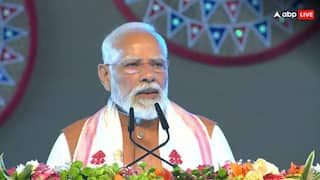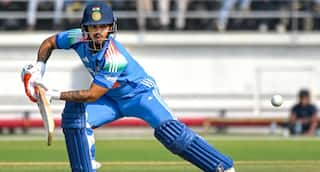Bone And Joint Day: Herniated Disc, Sciatica, Osteoporosis — Conditions That Can Cause Pain In Lumbar Spine Vertebrae
Bone and joint day: A person might suffer from pain in the L3-L4, or L4-L5 in the lumbar spine vertebrae due to multiple reasons such as bone and joint disorders. These cause waist or hip pain.

Bone and joint day: Bone and joint disorders are of different kinds, and can cause severe pain and discomfort. A person might suffer from pain in the L3-L4, or L4-L5 in the lumbar spine vertebrae due to multiple reasons such as bone diseases and joint disorders or injuries. L1 to L5 are the five lumbar spine vertebrae, and are the largest vertebrae in the entire vertebral column. L5-S1 is a disc at the bottom of the lower back, and includes L5 and S1, the first bone of the sacrum.
L3-L4, L4-L5, and L5-S1 are the discs most likely to suffer from pain because nerves are trapped in these areas as they help support two-thirds of the total body weight.
Conditions that cause pain the lumbar spine vertebrae, and surrounding regions
Slipped, herniated or disc bulges or protrusions that occur at the bottom of the lower back can cause pain in the waist or hip. This pain often radiates to the regions around the hip, the thighs, and lower leg and foot because the sciatic nerve, which runs from the bottom three vertebrae to the foot, becomes trapped.
While the sciatic nerve runs along the back of the leg, the femoral nerve runs along the front. When a nerve is trapped at L2, L3 or L4, a person is likely to suffer from femoral nerve impingement, and experience pain in the front of the thigh.
ALSO READ | Bone And Joint Day: Osteoporosis, Osteomyelitis, Lupus, Bursitis – Bone Diseases And Joint Disorders
Therefore, sciatic pain occurs when nerves in the L3 to S3 levels, which innervate the back of the leg, are trapped, and femoral nerve impingement is characterised by pain in the L2 to L4 levels, which innervate the front of the thigh.
There could be different causes of trapped nerves in the spine, including herniated or bulging discs, spinal stenosis, and degenerative disc disease.
When the outer wall of an intervertebral disc bulges out from its normal position, it may press against nerves directly, leading to a loss of disc height, and the exit of the nerve out of the vertebral column.
ALSO READ | Women Experience Rapid Bone Loss After Menopause, Osteopenia Develops ‘Silently’, Experts Say
When the nucleus of the disc breaks through the outer disc wall, the condition is known as a herniated disc. Not only is there a loss of disc height but also pressure is applied on the spinal nerves by the nuclear material. The nuclear material of the disc may also biochemically irritate the disc nucleus, according to Buxton Osteopathy Clinic.
The buildup of bony deposits in the vertebrae is known as spinal stenosis, and usually occurs as a person ages. Spinal stenosis can exert pressure on nerves.
Facet joint arthropathy is the condition characterised by extreme pain in the facet joints (joints which link two vertebrae). These joints are worn down, and exert pressure on the spinal cord.
Degenerative disease is a condition characterised by pain in the neck and back due to wear and tear of the spinal disc.
ABP Live spoke to Dr Indranil Halder, Sr Consultant Orthopaedic & Joint Replacement Surgeon, Ujala Cygnus Group of Hospitals, Moradabad; Dr Debashish Chandra, Lead Consultant, Orthopaedics, CK Birla Hospital, Haryana; and Dr Satyakam Baruah, Senior Consultant, Minimally Invasive Brain and Spine Surgery, Department of Neurosurgery, Amrita Hospital, Faridabad, and asked them about the various reasons behind pain in the lumbar spine vertebrae, and surrounding regions.
Herniated disc, spinal stenosis, sciatica, muscle and ligament strain, arthritis, bursitis, muscle fatigue, osteoporosis, spondylitis, Vitamin D and B12 deficiencies, facet joint arthropathy, and ankylosing spondylitis are the major conditions responsible for extreme pain in the waist and hip region, the experts said.
Dr Baruah said that the exact cause of the pain is multifactorial, but the most common underlying condition is faulty spinal posture.
“Extreme pain in the waist and hip region can be a debilitating condition that affects a person's quality of life. As mentioned earlier, the pain can occur in the L3-L4 segment or the L4-L5 segment and may radiate to the thighs and lower limbs. The exact cause of this pain is often unclear,” Dr Halder said.
He explained that a herniated disc, also known as slipped disc, occurs when the disc between the vertebrae, a soft-cushion-like material, bulges or ruptures, and puts pressure on nearby nerves, resulting in sharp and shooting pain in the lower back, hips, and legs.
Dr Halder said that spinal stenosis, which refers to the narrowing of the spinal canal due to the development of bony deposits, can put pressure on the spinal cord or nerves, leading to pain, weakness and numbness in the waist, hip, and legs.
Dr Chanda explained that radiating pain on one side or both sides of the vertebral column may be indicative of a slip disc. “It generally happens due to heavy weight-lifting, sleeping on uneven surfaces, and sitting on the floor”.
Dr Halder said that sciatica can result in shooting pain along the pathway of the sciatic nerve. “Sciatica is a condition that occurs when the sciatic nerve, which runs from the lower back through the hips and down each leg, becomes irritated or compressed. This can result in shooting pain, tingling, or numbness along the nerve's pathway.”
He also said that muscle and ligament strain in the waist and hip area can result in limited mobility, making it difficult for the patient to lift things up.
The spine and hip joints can be affected by both spondylitis and osteoarthritis.
Spondylitis is a chronic slip disc condition in which the disc gradually migrates, and osteoarthritis is a disease that can affect any joint but mainly affects the spine and the knees.
ALSO READ | No Cure, But Food Rich In Proteins And Minerals Helps Control The Condition, Experts Say
Dr Halder and Dr Chanda said that ankylosing spondylitis can also affect the spine and result in extreme pain and stiffness in the lower back, waist and hip region.
Ankylosing spondylitis is a form of painful, ongoing joint inflammation, or chronic inflammatory arthritis and an autoimmune disease that causes inflammatory lower back pain, and eventually impairs spinal mobility severely due to structural changes leading to spinal fusion.
Ankylosing spondylitis is caused by a combination of environmental and genetic factors, the HLA-B27 gene playing a significant role in increasing the risk of the disease.
ALSO READ | What Factors Determine Whether Cancer Occurs In Oral Cavity, Larynx Or Pharynx? Here’s What Experts Say
The disease mainly affects the spine, and is characterised by symptoms such as chronic back pain and stiffness. Early symptoms of the disease usually arrive between the ages of 15 and 30. People who lead a sedentary lifestyle experience more pain due to the disease compared to others, but can manage the symptoms through regular physical activity.
The disease causes inflammation of the joints between the pelvic bones, also called the ilia, and the base of the spine, also called the sacrum. The joints between the ilia and the sacrum are called sacroiliac joints. Sacroiliitis is the inflammation of these joints, and gradually spreads to the joints between the vertebrae. The inflammation eventually involves the whole spine, and results in a condition known as spondylitis.
When the vertebrae fuse together, back movement becomes limited. Ankylosis refers to the progressive bony fusion. Bones that become fused tend to fracture.
When inflammation of tendon attachments to bones occurs, the condition is called enthesitis. About 20 per cent of patients who eventually develop ankylosing spondylitis when they grow up start suffering from enthesitis associated arthritis from childhood.
Joints of the shoulders, hips, knees, and those between the spine and ribs can also be affected in people suffering from ankylosing spondylitis. When the joints between the spine and ribs are affected, people suffer from restricted movement of the chest, and this makes it difficult to breathe deeply.
Dr Chanda said that apart from spinal posture, rheumatoid arthritis can cause lower back pain to radiate to the legs.
Rheumatoid arthritis is an autoimmune disorder which affects the lining of joints, causing a painful swelling that can result in bone erosion and joint deformity.
“The pathophysiology leading to pain in diseases such as rheumatoid arthritis and ankylosing spondylitis is a change in the bony and ligamentous structures due to the disease process itself,” Dr Chanda said.
He said that lifestyle factors such as not performing household chores, and sitting for long durations while working from home could contribute to lower back pain.
He explained that prolonged fatigue can cause muscle fatigue, leading to back pain. “Patients may experience relief initially but after sitting for extended periods, which are more than half-an-hour or 40 minutes, their back may start to ache and feel stiff, making it difficult to sit for longer durations.”
He said that reduced sunlight exposure has resulted in Vitamin D deficiency, leading to weaker bones and eventually, osteoporosis and back pain. “Vitamin B12 deficiency also leads to bone weakness and muscle wasting, contributing to back pain.”
A less common cause of lower back pain that radiates to the legs are avascular necrosis. This is a disease that occurs due to the temporary or permanent loss of blood supply to the bone.
Dr Baruah explained that extreme sharp and shooting pain in the back or waist region with radiation to the leg on one side is known by different names such as acute low backache, acute lumbago, or sciatica. However, the disease can be broadly attributed to lumbar spondylosis.
ALSO READ | The Science Of Health: Arbovirus Diseases, Enteric Diseases, Sleeping Sickness – Illnesses Spread By Insects
Lumbar spondylosis refers to the degeneration of the lumbar vertebrae, and is characterised by the breakdown of one or more discs that separate the vertebrae. Degenerative disc disease is a type of lumbar spondylosis. About 60 to 85 per cent of adults are affected by low back pain during some point in their lives.
“The degenerative condition leads to the remodelling of the vertebral column, the intervertebral discs, joints, ligaments, and other soft tissues around the spinal canal. When these changes lead to compression of the neural elements of the spine, it leads to severe shooting pain along particular segments supplied by the specific nerve roots,” Dr Baruah said.
He also explained that the numerous bones, joints, and ligaments of the spine, stretching from the head to the pelvis, act to help transmit weight in an efficient and physiological manner, and that large paraspinal muscles provide further support to the spine to maintain the correct spinal axis and balance, while transmitting the weight to the major joints, such as the hips and knees, and then finally to the ground.
“Any abnormality of this axis due to prolonged improper spinal posture induces compensatory changes in the bony joints, ligaments, and muscles trying to maintain the correct axis and balance. These changes can balance the spinal axis, no doubt, but at a cost. These changes, such as thickening of the ligaments, new bone formation (osteophytes), facet joint arthropathy, or degeneration, finally lead to compression of the neural elements, which manifests as severe pain that is more often than not debilitating and affects the quality of life of the individual,” Dr Baruah explained.
However, he said, there are several instances in which the condition of lumbar spondylosis is neglected, and it worsens to the extent where the large paraspinal muscles of the lower back are no longer able to compensate for the abnormality in the spinal axis, leading to severe spasm.
ALSO READ | The Science Of Health: How Egg Freezing Is Performed, Its Risks, And How Much It Costs In India
How can lower back pain be treated?
Experts said that lower back pain can be managed through rest, by correcting spinal posture, performing isometric exercises, taking epidural injections, undergoing surgeries, taking over-the-counter pain relievers and muscle relaxants, among others.
“The best way to address this is through rest, pain management, correcting spinal posture, and isometric back strengthening exercises. Invasive spinal epidural injections and surgeries are options for patients who do not respond to a trial of medical management, whose symptoms are severe and incapacitating, or those with neurological deficits,” Dr Baruah suggested.
Dr Halder said that pain management involves taking prescribed medications, over-the-counter pain relievers, and muscle relaxants to alleviate pain and discomfort.
He also said that physical therapy can help improve flexibility, strengthen muscles, and alleviate pressure on affected areas.
“Corticosteroid injections can reduce inflammation and provide temporary pain relief. In severe cases where conservative treatments are not effective, surgery may be recommended to address the underlying cause of the pain,” Dr Halder said.
He concluded that it is crucial to avoid self-diagnosis based on internet information because each individual's condition is unique, and if one is experiencing extreme pain in the waist and hip region, it is important to seek medical advice from a qualified healthcare professional for a proper evaluation and personalised treatment approach.
Check ABP Live's stories explaining the science behind various health phenomena, and the articles appearing in the weekly health column here.
Check out below Health Tools-
Calculate Your Body Mass Index ( BMI )







































